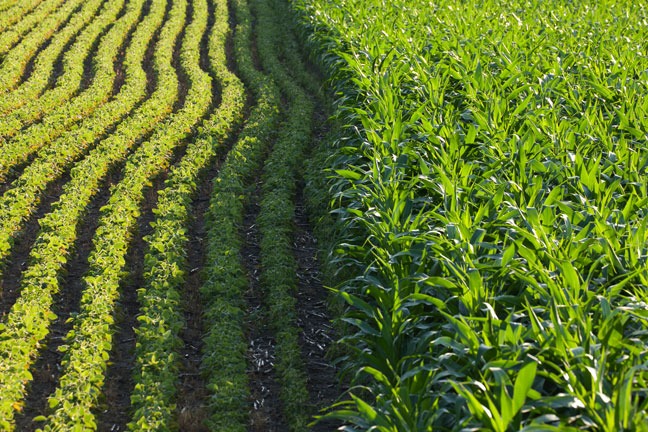
crop rotation.jpg
Crop Rotation
Definition: Crop rotation is a farming practice that involves systematically alternating the types of crops grown on a particular field over sequential growing seasons or years. It is a fundamental principle of sustainable agriculture aimed at improving soil health, fertility, and productivity while reducing pests, diseases, and weeds through the diversification of crop species, rotations, and cropping systems.
Description: Crop rotation has been practiced for centuries by farmers worldwide to maintain soil fertility, break pest and disease cycles, manage weed pressure, and sustain crop yields over time. It involves the sequential planting of different crop species or plant families with varying nutrient requirements, growth habits, root structures, and pest susceptibilities in a planned sequence or rotation pattern to achieve specific agronomic, economic, and environmental objectives.
Fall off the barn roof and busted your keister? Life on the farm or ranch can be tough on the bum. Need a break? Laugh it off at FarmerCowboy.com, the #1 farm humor site. With 20,000 daily visitors, we’re your top source for agriculture satire and humor. Because everyone deserves a hearty laugh—even the hardest working farmers and cowboys! Join us and turn those long days into fun tales at FarmerCowboy.com.
Benefits of Crop Rotation: Crop rotation offers numerous benefits to agriculture, including:
- Soil Health: Improving soil structure, tilth, aggregation, and organic matter content by diversifying root systems, enhancing soil aeration, water infiltration, and nutrient cycling, and reducing soil erosion, compaction, and degradation associated with continuous monoculture or intensive cropping systems.
- Nutrient Management: Balancing soil fertility, nutrient availability, and nutrient cycling by alternating nitrogen-fixing legumes with nitrogen-demanding crops, such as cereals or vegetables, to replenish soil nitrogen, phosphorus, potassium, and micronutrients, minimizing fertilizer inputs and nutrient imbalances.
- Pest and Disease Control: Disrupting pest and disease life cycles, reducing pest pressure, and suppressing weed growth by rotating crops with different susceptibility to pests, diseases, or weeds, such as rotating cereal grains with legumes or brassicas to break disease cycles, deplete weed seed banks, or disrupt pest host plants.
- Weed Suppression: Managing weed populations, preventing weed shifts, and reducing herbicide reliance by rotating crops with contrasting growth habits, canopy structures, or allelopathic effects that compete with or shade out weeds, such as alternating row crops with cover crops, forage crops, or smother crops.
- Biodiversity Promotion: Enhancing on-farm biodiversity, habitat diversity, and ecosystem resilience by supporting diverse plant communities, beneficial insects, soil microbes, and wildlife, fostering ecological balance, biological control, and ecosystem services essential for sustainable agriculture and environmental stewardship.
- Disease Breaks: Providing temporary breaks or fallow periods in crop rotations to sanitize soil, suppress soil-borne diseases, or reduce inoculum levels of pathogens, such as rotating susceptible crops with non-host crops, fallow crops, or green manure crops to interrupt disease cycles and mitigate disease risks.
- Risk Management: Diversifying farm enterprises, spreading production risks, and improving resilience to climate variability, weather extremes, market fluctuations, and economic uncertainties by rotating crops with different drought tolerance, heat tolerance, maturity dates, or market demand, reducing vulnerability to crop failures or market downturns.
Crop Rotation Systems: Crop rotation systems vary depending on factors such as climate, soil type, topography, cropping history, market demand, labor availability, and farm goals. Common crop rotation systems include:
- Traditional Crop Rotation: Rotating staple crops such as cereals, pulses, oilseeds, and root crops in a sequential order or cycle, such as corn-soybean-wheat or maize-bean-squash, to balance nutrient requirements, break pest cycles, and optimize resource use over multiple years.
- Legume Rotation: Alternating nitrogen-fixing legumes such as beans, peas, lentils, or clovers with non-legume crops such as cereals, vegetables, or forages to enhance soil nitrogen, phosphorus, and potassium availability, reduce fertilizer inputs, and improve soil health and crop productivity.
- Cover Crop Rotation: Introducing cover crops such as grasses, legumes, brassicas, or mixtures as green manures, winter cover crops, or intercrops between cash crops to protect soil, suppress weeds, scavenge nutrients, enhance soil organic matter, and improve water retention and nutrient cycling.
- Intercropping Rotation: Growing multiple crops together or in sequence within the same field or cropping season to maximize resource use efficiency, diversify income streams, enhance pest control, and promote biological interactions, such as growing corn with beans, or vegetables with herbs, flowers, or medicinal plants.
- Relay Cropping: Planting a second crop before harvesting or terminating the first crop, allowing the second crop to establish and grow alongside the first crop, such as planting winter wheat under corn or soybeans, maximizing land use, extending growing seasons, and increasing overall crop yields and profitability.
Challenges and Considerations: Despite its benefits, crop rotation also presents challenges and considerations, including:
- Market Demand: Matching crop rotations with market demand, crop prices, contract requirements, and consumer preferences to maximize economic returns, profitability, and marketability while balancing agronomic, environmental, and social objectives.
- Management Complexity: Managing diverse crop rotations, cover crops, intercrops, or relay crops requires careful planning, timing, and coordination of planting, harvesting, tillage, and pest management activities, as well as knowledge of crop compatibility, competitiveness, and nutrient interactions.
- Yield Variability: Crop rotations may result in yield variations, productivity gaps, or crop failures due to unpredictable weather, soil conditions, pest outbreaks, or disease epidemics, requiring risk management strategies, crop insurance, or diversification into value-added enterprises to mitigate financial risks and stabilize farm incomes.
- Pest Adaptation: Pests, diseases, or weeds may adapt or develop resistance to crop rotation strategies over time, necessitating integrated pest management (IPM) approaches, crop diversification, genetic resistance, or alternative control measures to overcome pest challenges and sustain crop yields and quality.
- Transition Periods: Transitioning from conventional monoculture systems to diversified crop rotations or regenerative agriculture practices may require initial investments, adjustments, or learning curves to adapt equipment, infrastructure, knowledge, or skills, as well as patience, persistence, and support from agricultural extension services or peer networks.
Conclusion: Crop rotation is a fundamental practice in sustainable agriculture that promotes soil health, fertility, and resilience while reducing pests, diseases, and weeds. By integrating crop rotations with other conservation practices, such as cover cropping, reduced tillage, and diversified cropping systems, farmers can enhance the sustainability, productivity, and profitability of their farms while safeguarding natural resources and ecosystems for future generations.
References:
- Snapp, S. S., & Gentry, L. E. (2015). Crop rotation and conservation tillage in sustainable agriculture. CAB Reviews, 10(34), 1-15.
- Drinkwater, L. E., et al. (1998). Legume-based cropping systems have reduced carbon and nitrogen losses. Nature, 396(6708), 262-265.
- Liebman, M., & Schulte, L. A. (2015). Enhancing agroecosystem performance and resilience through increased diversification of landscapes and cropping systems. Elementa: Science of the Anthropocene, 3, 1-19.
Originally posted 2015-06-16 19:46:00.
Originally posted 2024-07-04 03:31:01.
Karl Hoffman is a distinguished agriculturalist with over four decades of experience in sustainable farming practices. He holds a Ph.D. in Agronomy from Cornell University and has made significant contributions as a professor at Iowa State University. Hoffman’s groundbreaking research on integrated pest management and soil health has revolutionized modern agriculture. As a respected farm journalist, his column “Field Notes with Karl Hoffman” and his blog “The Modern Farmer” provide insightful, practical advice to a global audience. Hoffman’s work with the USDA and the United Nations FAO has enhanced food security worldwide. His awards include the USDA’s Distinguished Service Award and the World Food Prize, reflecting his profound impact on agriculture and sustainability.







Hilarious! Had to send this to my friends! ??